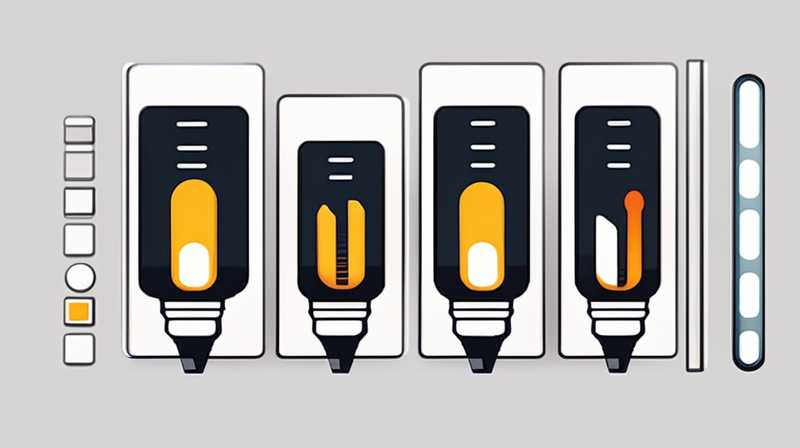
To determine the appropriate wattage for solar street lights, consider several integral factors. 1. The required illumination level is crucial, ranging from 30 to 150 watts based on specific needs and environmental conditions. 2. Location plays a vital role, while urban areas may demand higher output for street safety and visibility. 3. Lighting duration influences wattage, where longer operational periods require increased energy capacity. 4. Solar panel efficiency and battery life are essential components of the system, impacting overall effectiveness.
Let’s delve deeper into each aspect that can guide the selection of optimal wattage for solar street lights.
1. UNDERSTANDING ILLUMINATION REQUIREMENTS
Illumination standards vary considerably depending on the area needing lighting. Urban thoroughfares typically require brighter lights compared to rural roads. This discrepancy in illumination levels can be attributed to several factors, including safety concerns, activity levels, and the presence of pedestrians or cyclists.
For instance, a busy intersection might necessitate 100 to 150 watts to ensure adequate visibility at night, whereas a quieter residential street could effectively utilize 30 to 60 watts. Aligning the appropriate wattage with local regulations and community expectations can also influence the success of street lighting projects.
Furthermore, understanding the desired ambiance is key; some areas may benefit from softer lighting, while others might prioritize bright, focused beams. Each lighting scenario has its unique requirements, and those planning installations must consider these variations carefully.
2. FACTORS IMPACTING LOCATION
Location plays an essential part in deciding the wattage. Environmental variables such as tree coverage, urban density, and traffic levels are all influential. In dense urban settings where buildings obstruct light, higher-wattage fixtures become necessary to counterbalance the dilution of illumination.
Additionally, street lighting in rural areas, which often encounters less ambient light pollution, might require careful consideration of the wattage to balance energy consumption and environmental impact. The surrounding infrastructure significantly influences light placement and intensity.
Considerable attention must also be directed toward seasonal variations. Regions that experience long nights in winter may see a spike in wattage decisions differently compared to regions with comparatively shorter night hours.
3. DURATION OF LIGHTING USAGE
Another essential determinant in wattage selection is how long the street lights will function daily. The illumination duration directly relates to overall energy consumption and system design requirements. For example, lights that operate for a full night, typically wanting from 10 to 12 hours of illumination during the darker months, might require higher wattage options to ensure adequate lighting throughout the entire duration.
The reliance on motion sensors can play a role in wattage decisions as well. If installed correctly, motion-activated lights could operate at lower wattage levels until needed, allowing for energy efficiency without sacrificing safety. Facilities that determine the functional hours of street lights will be able to allocate resources in a much more precise manner.
Conversely, lights that remain active throughout the entire night could demand systems designed to support greater wattages. Evaluating anticipated peak usage periods is crucial to making the right choice for wattage.
4. SOLAR PANEL EFFICIENCY AND BATTERY LIFE
Wattage decisions are not solely influenced by the strength of the light itself but also the capabilities of the solar panels and battery systems that power them. Your solar panel’s capacity will dictate how much energy can be stored during the day, and this directly affects the performance of the lights at night.
Examining the solar panel size and efficiency can guide choices regarding wattage. High-efficiency panels can produce more power within the same surface area, possibly allowing for lower wattage fixtures. Conversely, if panel efficiency is low, users may need to invest in higher wattage systems to counterbalance potential energy shortfalls.
Battery storage is equally crucial. A strong battery capable of holding sufficient charge will enable longer lighting operation and enhanced efficiency. Understanding backup systems for cloudy days or extended gray periods is essential to ensure reliable performance.
5. REGULATIONS AND STANDARDS
Municipal and regional regulations play a significant role in making wattage selections for solar street lighting systems. Standards can dictate maximum and minimum light levels, which might necessitate particular wattage choices to comply with local laws. Understanding these hurdles is vital for a well-planned deployment.
Additionally, city planners may have specific preferences for light color temperatures and brightness distributions. These preferences can also affect the wattage needed to fulfill the legal illuminance requirements set forth by governing bodies.
Engaging with local regulatory agencies can help clarify potential constraints that many developers often overlook. Incompatibility with pre-established standards can often lead to costly redesigns and adjustments.
6. COST CONSIDERATIONS
While wattage is essential, associated costs for initial investments and ongoing maintenance will weigh heavily on overall project viability. Higher wattage systems generally incur greater upfront expenses, including hardware and installation fees.
Moreover, ongoing energy production demands must be taken into account. Systems with higher wattages may require bigger solar panels and batteries, whose costs can accumulate significantly over time. Conducting comprehensive cost-benefit analyses will guide stakeholders towards sustainable investments.
Furthermore, availability and longevity of components must also be considered. Opting for well-reviewed products with robust warranties can minimize future financial strain.
7. ENVIRONMENTAL IMPACTS
Lastly, examining environmental ramifications is crucial when deciding on wattage for solar street lights. Sustainable systems can significantly reduce energy consumption and carbon footprints compared to traditional street lighting methods.
Evaluating local biodiversity and nocturnal wildlife’s sensitivity to light pollution is essential as well. Employing lower-wattage fixtures in certain environmentally sensitive areas can mitigate wildlife disruptions.
By assessing the ecological consequences and selecting products that promote sustainability, stakeholders can ensure that solar street lighting maintains a balance between human needs and environmental integrity.
8. TECHNICAL ADVANCEMENTS
As technology continues to evolve, more advanced options enable stakeholders to reconsider wattage selections and broaden their possibilities. Smart technologies, including IoT-enabled street lights, can allow for precise control over illumination levels based on real-time data.
Through these advancements, stakeholders can optimize energy use while still achieving necessary light levels tailored to varying conditions. The integration of advanced sensor systems that adjust brightness according to surrounding environments promotes significant energy savings while meeting illumination requirements.
Investing in modern technology can inspire communities to explore new solar applications beyond traditional street lighting. Its adaptability offers significant advantages in terms of achieving energy efficiency and enhanced functionality.
9. INSTALLATION CONSIDERATIONS
Once the appropriate wattage has been determined, installation plays a crucial role in lighting performance. Understanding the installation landscape – such as ground conditions, pole heights, and proper orientation of solar panels – is integral to maximizing efficiency.
The effectiveness of solar street lighting systems hinges on precise installation practices, which include correct alignment for optimal sunlight exposure and accurate fixture placement for uniform light distribution. Employing experienced installers who understand these intricacies can ensure that systems deliver as intended.
Additionally, provisions for routine maintenance and monitoring systems can prevent common installation pitfalls from leading to system failures over time. Scheduled checks help ensure that solar panels and fixtures remain clean and operational, thereby preserving their longevity.
10. FUTURE TRENDS AND INNOVATIONS
There is a growing interest in innovative solutions related to wattage selection for solar street lighting. Emerging technologies involving solar energy storage, smart grid functioning, and renewable energy integration are being explored to enhance overall system performance.
These innovations can lead to significant changes in how communities approach solar street lighting projects. Future trends may pivot toward even more energy-efficient systems leveraging artificial intelligence to adapt lighting levels dynamically based on varying traffic patterns or changing weather conditions.
Investing in these forward-thinking approaches allows for a reduction in peak energy demand, ultimately leading to lower operational costs and promoting sustainability. Therefore, stakeholders should remain informed about trends that may redefine conventional understandings of wattage requirements.
FAQs
HOW DO I DETERMINE THE PROPER WATTAGE FOR MY SOLAR STREET LIGHTS?
Determining the appropriate wattage for solar street lights involves assessing several parameters. Firstly, you need to consider the illumination requirements. Locations with higher pedestrian traffic or vehicle volumes generally require brighter lights, typically around 100 to 150 watts. If the area is residential or less trafficked, 30 to 60 watts might suffice.
Secondly, consider the environmental conditions. Regions with consistent cloud cover or heavy tree canopies may necessitate stronger systems to ensure adequate light penetration. Furthermore, evaluate the duration the lights are needed each night. Longer hours of illumination often require larger wattages to maintain brightness throughout the operational period.
Lastly, always evaluate the efficiency of the solar panels in conjunction with battery storage capabilities. Efficient solar panels and powerful batteries can contribute to lower wattage requirements, optimizing performance under various conditions.
WHAT IS THE ROLE OF SOLAR PANELS IN DETERMINING WATTAGE?
Solar panels are pivotal in determining how much wattage you might need for your solar street lights. The capability of your panels to convert sunlight into electrical energy dictates how efficiently your system performs overall. High-efficiency panels can convert more sun exposure into usable energy throughout the day.
If the solar panels underperform or are inadequately sized, this can lead directly to insufficient power for the designated wattage, especially during periods of low sunlight. Proper alignment and installation of solar panels are also crucial to maximize energy collection.
Additionally, understanding the sunlight hours in your region can help predict the daily energy generation, which informs the necessary wattage. Consequently, the effectiveness of a solar street lighting system hinges significantly on selecting the right panels to meet wattage needs effectively.
HOW DO WEATHER CONDITIONS AFFECT MY CHOICE OF WATTAGE?
Weather conditions play an influential role in choosing the appropriate wattage for solar street lights. Areas that experience long periods of cloudy or rainy weather may require higher wattage fixtures to compensate for energy deficiencies during these times.
In contrast, regions with abundant sunlight can support lower wattage options since energy generation during the day will be much higher. Understanding local weather patterns can shape decisions about both solar panel size and battery storage capacities.
Additionally, weather considerations should influence installation choices. Regular checks to ensure cleanliness of solar panels can significantly impact their efficiency and energy generation, particularly in dusty or pollen-laden environments. Therefore, one must balance wattage requirements with anticipated weather variability for optimal performance.
FINAL THOUGHTS
Selecting the ideal wattage for solar street lights requires a nuanced understanding of various interconnected elements. Prioritizing illumination needs, environmental factors, operational durations, and advancements in solar technology can lead to informed decisions and effective solutions for communities.
Through these insights, stakeholders can ensure investments in solar lighting systems yield enhanced safety, energy efficiency, and environmental sustainability. Careful planning and a commitment to leveraging emerging innovations will enable communities to navigate the complexities of street lighting successfully.
Moreover, community engagement and alignment with regulatory bodies are crucial aspects of the process, ensuring that installed systems meet both local needs and regulations. Ultimately, by approaching wattage selection holistically, communities can optimize their solar street lighting solutions while navigating future challenges and opportunities for sustainable urban planning. The transition towards solar street lighting signifies a crucial step towards more sustainable energy practices, reflecting a commitment to innovation, safety, and environmental stewardship.
Original article by NenPower, If reposted, please credit the source: https://nenpower.com/blog/how-many-watts-should-i-choose-for-solar-street-lights-2/


